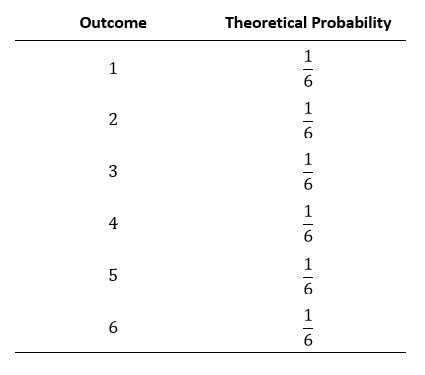An introduction to probability
Introduction to Probability
Probability of an Event
If all of the outcomes in an experiment are equally likely, then the probability of an event, E, occurring is given by:
Note: the number of outcomes that result in event E occurring can never be negative and can never be greater than the total number of outcomes, so we know:
Theoretical Probability vs. Empirical Probability
A probability computed by using a probability formula is called a theoretical probability.
A probability found by observing the actual outcomes of an experiment that is repeated many times is called empirical probability.
Consider rolling a 6-sided die.
We know that each outcome is equally likely, so the theoretical probabilities are as follows:
However, if we actually rolled a 6-sided die 600 times and recorded the outcomes, we may find that the empirical probabilities differ:
(Geogebra [1] is a great tool for simulating this experiment)
Notice only one outcome (rolling a 5) matched the theoretical probability.
contributed by David Ciskowski
What is probability?
Probability is the likelihood that an event will occur and is calculated by dividing the number of favorable outcomes by the total number of possible outcomes. In Statistics, the probability distribution gives the possibility of each outcome of a random experiment or event. It provides the probabilities of different possible occurrences.
Consider this example: When you flip a coin, there are only two possible outcomes. Heads or Tails. So the probability of getting heads is 1 out of 2 or 1/2 or 50%. There is a 50% chance of getting heads and a 50% chance of getting tails. Probability distribution maps out the likelihood of multiple outcomes in an equation or table, If we flip the two coins twice in a row, there are four possible outcomes. The is a distribution of
25% heads/heads 25% heads/tails 25% tails/tails 25% tails/heads
contribution by Tania Nicole Sutherland


